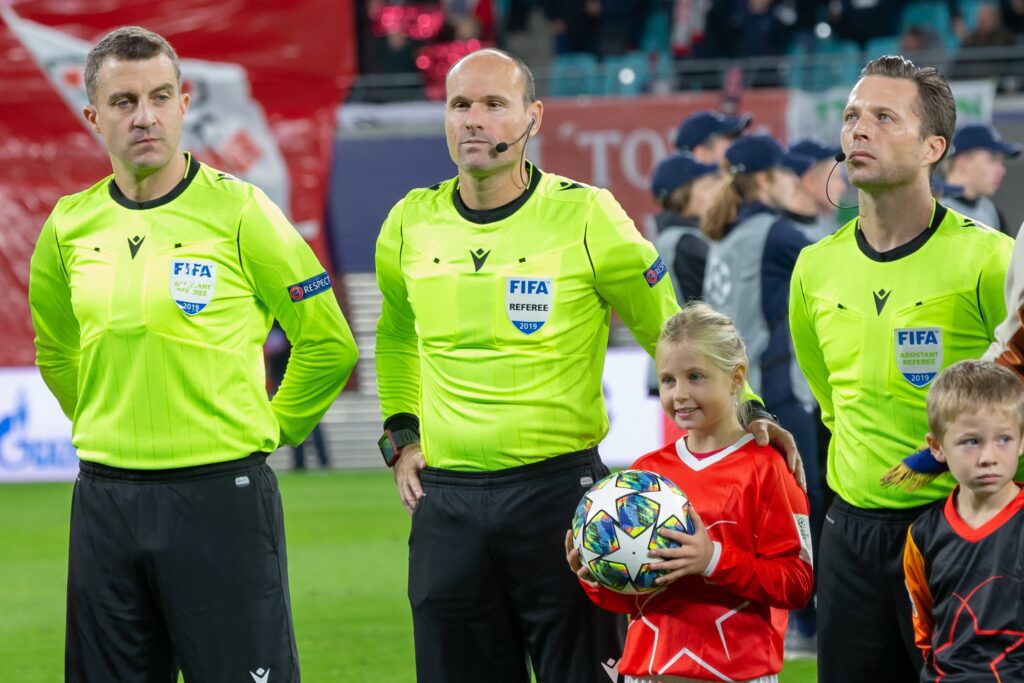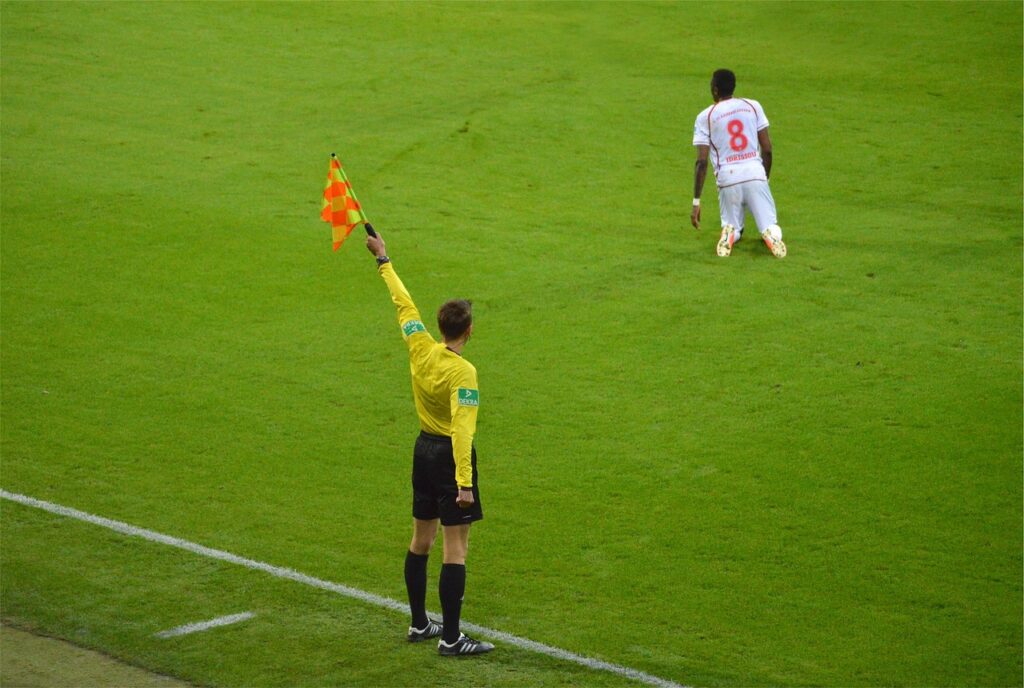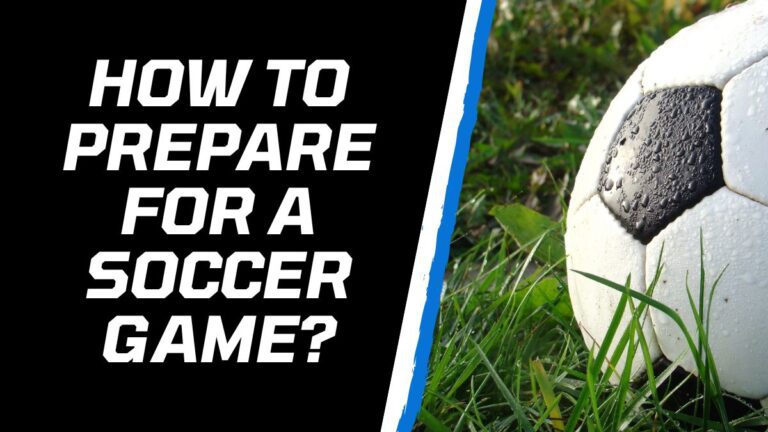How to Ref a Soccer Game Like a Pro (2024)
Have you ever watched a soccer game, mesmerized by the skillful players and the electric atmosphere, and thought, “Hey, I could do that refereeing thing!“? Well, guess what? You might be absolutely right!
This blog is your one-stop shop for everything you need to know about becoming a soccer referee. Whether you’re a seasoned player looking for a new challenge, a complete beginner curious about the game from a different perspective, or simply a passionate fan wanting a deeper understanding, this guide is for you.
We’ll take you on a journey, step-by-step, from learning the basic rules and cool hand signals refs use, to understanding how to manage the game and communicate effectively with players and coaches. No matter your experience level, this blog will equip you with the knowledge and tools to confidently step onto the field and become a respected referee. So, are you ready to blow the whistle and start your refereeing adventure? Let’s go!
The Fundamentals: A Referee’s Rulebook

Before diving into the nitty-gritty of managing the game, let’s solidify the foundation – the essential rules that every referee needs to know like the back of their hand (or, in this case, whistle!).
1. The Objective: Remember, the goal of both teams is to score by kicking the ball into the opponent’s net, using any part of the body except the hands and arms (except for the goalkeeper in their penalty area).
2. Out of Bounds: When the ball goes over the sideline or goal line, play restarts with a throw-in or a corner kick/goal kick, depending on which team last touched the ball and where it went out.
3. Fouls & Free Kicks: If a player commits a foul (like tripping or pushing an opponent), the opposing team receives a free kick, a chance to restart play from the spot of the foul. Depending on the severity of the foul, it can be direct (meaning you can score directly) or indirect (requiring another player to touch the ball before it goes in).
4. Offside: This can get tricky, but simply put, an attacking player is offside if they are closer to the opponent’s goal line than both the ball and the second-to-last defender when their teammate passes the ball forward. Being offside is a foul, unless the player receives the ball directly from a throw-in, goal kick, or corner kick.
5. Penalty Kicks: If a serious foul is committed inside the penalty area (the rectangular box near the goal), the offended team is awarded a penalty kick – a one-on-one shot against the goalkeeper from the penalty spot.
6. Yellow & Red Cards: Referees use colored cards to caution or dismiss players for misconduct. A yellow card is a warning, while a second yellow card or a serious offense results in a red card and ejection from the game.
These are just the core rules to get you started. Remember, mastering the complete Laws of the Game is crucial for any serious referee. But with dedication and practice, you’ll be well on your way to confidently calling the shots on the soccer field!
Pre-game Preparation

Refereeing a soccer game is no joke, and it’s important to be fully prepared before the match begins. The key to success is in the details, and this means knowing the rules, checking the field and equipment, and communicating with your co-referees and the teams.
But let’s be real here – the pre-game prep can be a bit overwhelming! Don’t worry, we’ve got you covered. First, familiarize yourself with the rules of the game. It’s essential to know the ins and outs of soccer so you can make the right calls and avoid confusion during the game.
Next up, check the field and equipment to make sure everything is in place. This means inspecting the field for any hazards, making sure the goals are set up properly, and checking the balls and other equipment. You don’t want any surprises during the game!
Lastly, communicate with your co-referees and the teams. It’s important to establish a good rapport with everyone involved in the game. This means introducing yourself, discussing any concerns or questions, and making sure everyone is on the same page. Remember, communication is key!
So, take a deep breath and get your game face on. With a bit of prep work, you’ll be ready to tackle any challenges that come your way during the match.
During the Game

Okay, so you’ve made it through the pre-game prep and the players are ready to hit the field. Now that the players are all set to start, it’s time for you to gear up and get ready to be the best ref you can be!
Starting the game may seem a little daunting at first, but don’t worry – it’s just a matter of following a few procedures. Make sure you check that all the players are wearing appropriate equipment and conduct a fair coin toss to decide which team starts the game.
When the game is in full swing, your positioning and movement are crucial. You want to make sure that you are in the right place at the right time to make accurate calls. Keep up with the fast pace of the game and always keep a safe distance from the players.
Making calls and decisions may be the toughest part of being a referee. You need to make split-second decisions based on what you see happening on the field. But remember, you are the authority figure, and your calls are final.
Handling conflicts and disputes may be a part of the job you’d rather avoid, but it’s important to be prepared. Listen to both sides, remain impartial, and make a fair decision based on the rules of the game.
Now that you know what to expect during the game, it’s time to get out there and have some fun! Remember to stay focused, stay alert, and enjoy the excitement of being a soccer referee. This is how you learn how to ref a soccer game in the best way possible.
After the Game: Reflect, File, and Improve

Congratulations! You made it through the game as a referee. But your job isn’t quite done yet.
Closing out the game is an essential part of your responsibility. Make sure that all the players and coaches are aware that the game has officially ended. Shake hands with both teams and thank them for playing a fair game.
Filing a report is another crucial step to complete after the game. Take note of any major incidents that occurred during the game, any disciplinary actions that you had to take, and any injuries. Your report will help officials understand what happened during the game and ensure that the appropriate action is taken.
Self-reflection and improvement are crucial to becoming a better referee. Take the time to think about what went well during the game and what didn’t. Identify areas where you could improve and work on them. By constantly striving to be better, you’ll become a more effective and confident referee.
Remember, being a soccer referee isn’t just a job; it’s a responsibility. By following these steps before, during, and after the game, you’ll become a more efficient and respected referee. So go out there, have fun, and make the game fair for everyone!
Final Thoughts
Learning how to ref a soccer game is not an easy task, but it is a rewarding one. It takes a lot of preparation, focus, and confidence to make the right calls and maintain order during the game. By following the steps outlined in this guide, you’ll be better equipped to handle any situation that arises and ensure that the game is played fairly and safely.
Remember, soccer is a team sport, and that includes the referees. Work together with your fellow officials to make sure that the game runs smoothly, and don’t be afraid to ask for help if you need it.
Finally, thank you for taking the time to read this guide. We hope it has given you the knowledge and confidence to become a great soccer referee. So go out there and enjoy the game!
Frequently Asked Questions (FAQ)
While learning how to ref a soccer game, here are some questions that frequently arise:
1. What does a good referee do during a soccer game?
A good soccer referee plays a crucial role in ensuring a fair and safe game. They enforce rules, make accurate calls, and maintain order on the field. To learn how to ref a soccer game, one must develop excellent communication skills and the ability to work effectively with players, coaches, and other officials.
Additionally, they must maintain a calm and controlled demeanor, even in the face of conflict or disagreement. Referees use clear and consistent signals to indicate fouls, offsides, and other rule violations, and keep accurate records of the game, including any cards issued, goals scored, and substitutions made.
2. What are the referee signals in soccer?
Referees use a variety of signals to communicate with players, coaches, and other officials during a soccer game. The most basic signal is the whistle, which referees blow to indicate the start or end of the game and to signal stoppages due to fouls, injuries, or other incidents.
Referees also use hand signals to indicate different types of fouls and rule violations, such as raising their hands to signal an offside or making a circular motion with their arms to indicate a corner kick.
Additionally, referees use cards to indicate when a player has committed a serious foul or has otherwise violated the rules. A yellow card indicates a caution, while a red card indicates a sending-off. It’s essential for players and coaches to be familiar with these signals so they can understand what is happening on the field and respond appropriately.
3. How many referees are in a soccer game?
The number of referees in a soccer game varies depending on the level of play and the competition’s rules. Most professional and international matches have three referees on the field: the head referee, who makes the majority of the calls, and two assistant referees, who help with offside calls and other decisions.
At the youth and amateur levels, there may only be one referee on the field or a team of two or three officials who share responsibility for making calls and enforcing the rules. Regardless of the number of referees, it’s essential for players, coaches, and officials to work together to ensure that the game is played fairly and safely.
4. Do soccer referees train?
Yes, soccer referees undergo training to develop the skills needed to officiate games effectively. This training typically includes learning the rules and signals of the game, as well as developing communication and conflict resolution skills.
Referees must also stay up-to-date on any changes to the rules and attend regular training sessions to ensure they are prepared to handle the challenges that arise during games. To learn how to ref a soccer game, individuals can attend courses offered by national and international soccer organizations.
5. How many km do referees run?
The distance that soccer referees run during a game can vary depending on the level of play, the size of the field, and the pace of the game. On average, referees at the professional level run between 8 and 13 kilometers per game. This distance can be covered in short bursts, as referees sprint to keep up with the players, or in longer distances as they move up and down the field.
Regardless of the distance covered, referees must maintain their physical fitness to ensure they are able to make accurate calls throughout the game.







